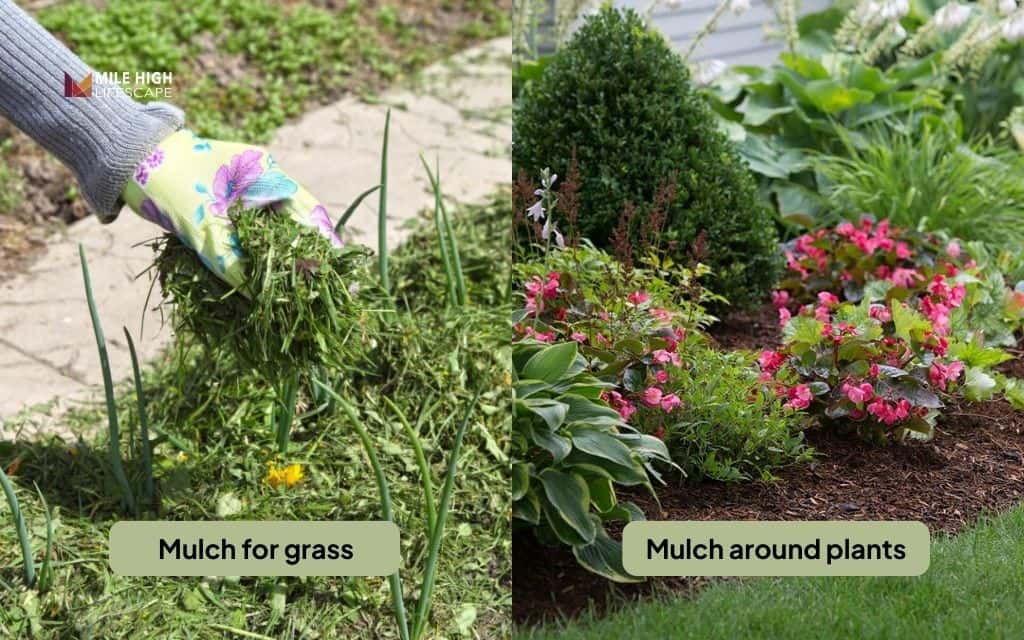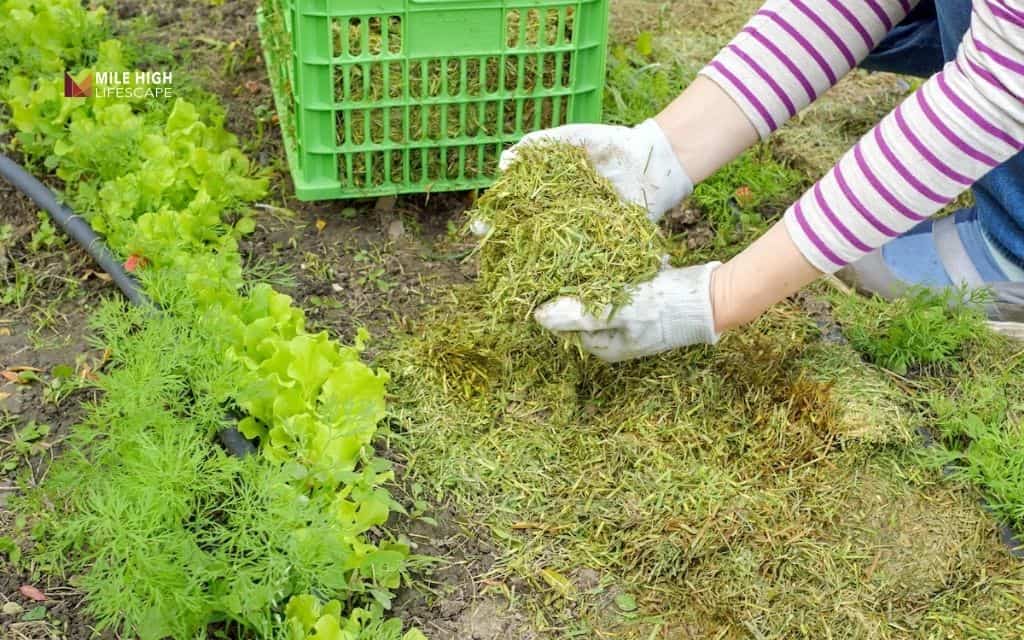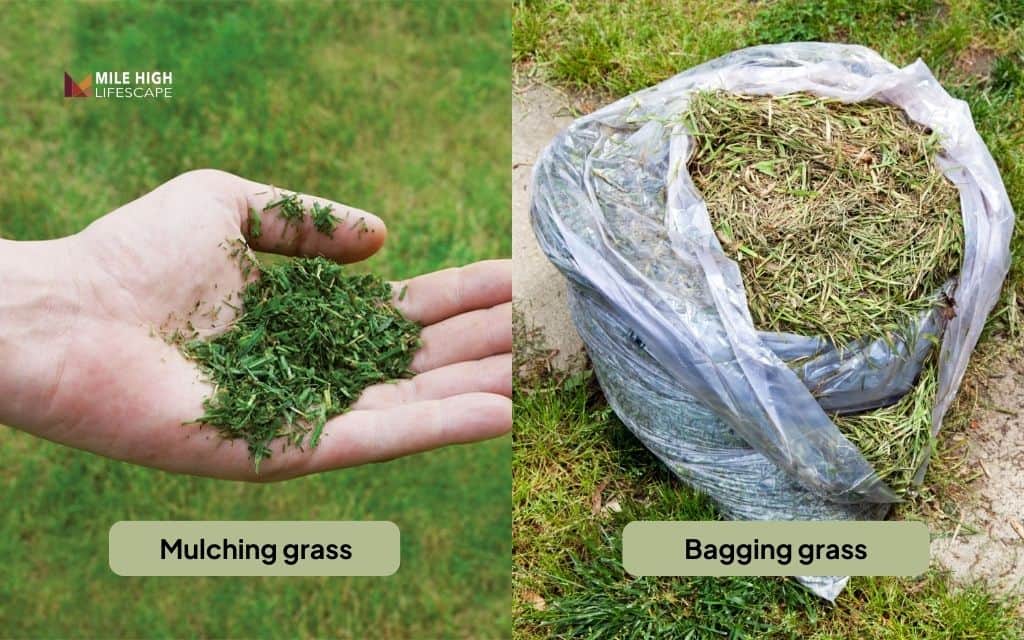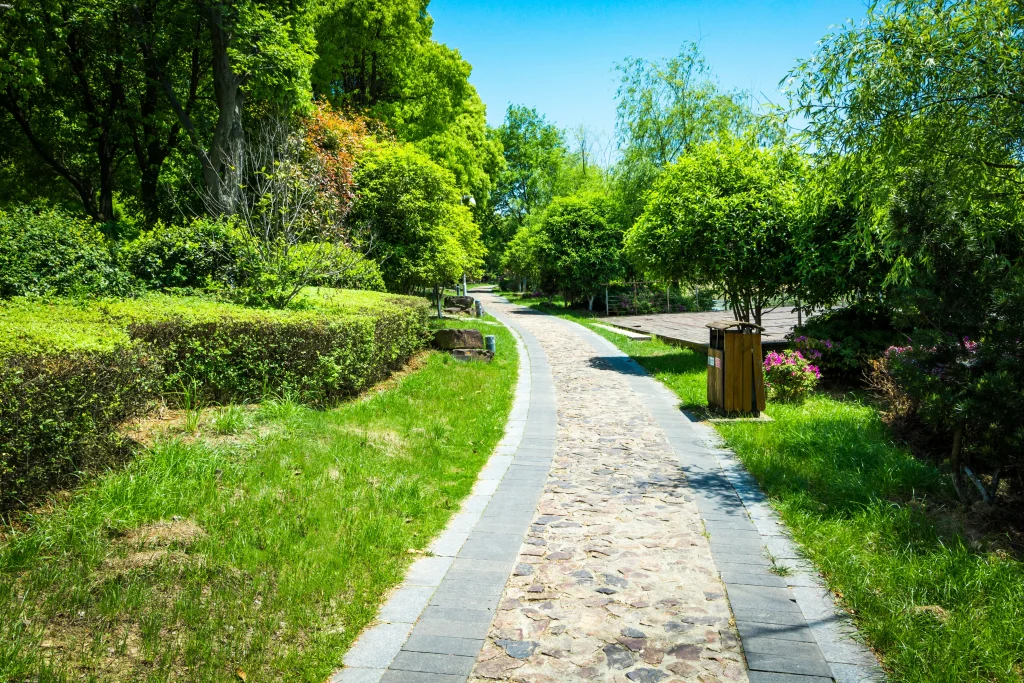You’re pushing your mower across a Denver lawn on a Saturday morning. The bagger is filled with clippings. You pause and wonder: “Should I mulch these clippings or haul them away?”
Mulching grass means using a mulching mower or mulch plug to chop clippings finely. The mower returns those tiny pieces to your lawn instead of collecting them in a bag. The blade cuts clippings multiple times before depositing them back into the turf.
Denver’s climate makes this decision more important than in other cities. The semi-arid climate creates a persistent moisture struggle. High UV exposure and thin air stress turf and water restrictions force you to make every drop count.
This guide shows Denver homeowners when, why, and how to mulch for grass in your lawn effectively. You’ll learn to save water, reduce fertilizer costs, and build tougher, greener turf that thrives in Colorado’s Front Range conditions.
What is mulching grass?
Mulching grass = recycling clippings in place
Your mower traps grass clippings inside the deck. The blade chops them repeatedly into pieces about one-quarter inch long. The mower then blows these tiny fragments back into the turf. Microbes break down the clippings within days. Nutrients return to feed your lawn.
This process differs from side-discharge mowing, where clippings land in windrows on your lawn. Mulching creates an even distribution of finely chopped material that disappears into the canopy.
Mulching vs bagging vs removing
Three main options exist for handling grass clippings:
- Mulching leaves clippings on the lawn as a nutrient source. The organic matter decomposes and feeds soil biology. Water retention improves. Fertilizer needs decrease.
- Bagging collects clippings into a container for disposal or composting. You remove nutrients from the lawn with every mowing. The grass clippings either go to the landfill or your compost pile.
- Raking or removing by hand requires the most labor. You strip away nutrients and organic matter that could benefit your soil. Time increases significantly compared to other methods.
“Mulch for grass” vs mulch around plants
Lawn mulch and landscape mulch serve different purposes in your Denver yard.
- Mulch for grass means chopped grass clippings or shredded leaves that integrate into the turf. These materials break down quickly.
- Bed mulch includes bark chips, wood mulch, or rock that surrounds shrubs and perennials. This material suppresses weeds and conserves moisture but breaks down slowly over months or years.

Is mulching good for lawns? (spoiler: yes)
Nutrient recycling
Grass clippings contain nitrogen, phosphorus, and potassium – the same nutrients in commercial fertilizer. When you mulch the lawn, these elements return to feed your turf. Research shows that recycled clippings can replace one to one-and-a-half fertilizer applications per season.
Moisture conservation
A thin layer of mulched grass clippings shades the soil surface. Evaporation decreases. Your lawn holds moisture longer between waterings.
The organic matter also helps soil absorb water more effectively. Compacted clay soils common along the Front Range benefit from this improved infiltration. Water reaches root zones instead of running off.
Better soil over time
Clippings feed beneficial soil microbes. These organisms improve soil structure and slowly build organic matter in compacted Denver soils. Over seasons, your lawn develops stronger root systems and better drought tolerance.
Native Colorado soils often contain less than one percent organic matter. Consistent mulching lawn practices can gradually increase this percentage, creating healthier turf that requires fewer inputs.
Time, money, and waste savings
Mulching grass cuts your fertilizer bill by 20 to 30 percent. You eliminate the time spent emptying bags, hauling clippings to the curb, or making trips to the disposal site. Denver charges tipping fees at some facilities – another cost you avoid. Notes that mowing more frequently while mulching actually takes less total time than bagging clippings.
How to mulch grass properly
Step 1: Set up your mower for mulching
A dedicated mulching mower works best, but you can convert most standard mowers. Install a mulch plug to block the discharge chute. This forces clippings to recirculate under the deck for additional cutting.
Replace or sharpen your blade. A sharp edge cuts cleanly and chops clippings finely. Dull blades tear grass, leaving ragged brown tips and larger clipping pieces that decompose slowly.
Clean the mower deck underside before each season. Built-up grass restricts airflow and reduces mulching effectiveness. Scrape or power-wash away old debris.
Step 2: Follow the “one-third rule”
Never remove more than one-third of the grass blade height in a single mowing. This principle protects your lawn from stress and ensures clippings remain short enough to filter into the turf quickly.
For Denver’s cool-season grasses maintain heights between 2.5 and 3.5 inches. Adjust within this range based on sun exposure. Shady areas benefit from slightly taller settings.

Step 3: Mow frequently enough
Plan to mow once or twice per week during peak spring and fall growth. This frequency keeps clippings short. Small pieces break down faster than long ones.
In summer heat, adjust your schedule. Grass grows slower but still needs regular cutting. Mowing every 5 to 7 days usually works well from June through August. Raise your cutting height a half-inch during extreme heat to reduce stress.
Step 4: Watch clipping density
After mulching, you should see grass blades—not a thick mat of clippings. If clumps appear on the surface, you’ve either waited too long between mowings or cut when grass was wet.
Fix clumping by making a second pass with the mower. Cross your original pattern at a 90-degree angle. This redistributes material and chops clumps further. Alternatively, use a leaf rake to spread heavy areas, then mow over them again.
Step 5: Adjust for denver weather swings
Colorado weather changes rapidly. A week of rain followed by hot sun can send grass shooting up. When you can’t maintain your regular schedule, temporarily bag clippings instead of creating smothering layers.
Raise your deck height slightly during late July and August when Denver lawns face maximum heat stress. Resume normal height and full mulching practices when cooler September weather arrives.
Mulching vs bagging – When each makes sense
When mulching is the best choice
Choose mulching lawn practices when you maintain a regular weekly schedule. Healthy turf with minimal disease pressure benefits most from returned clippings. The organic matter feeds soil biology and reduces fertilizer needs.
Water conservation becomes your priority during dry summers. Mulched clippings help soil retain moisture longer between irrigation cycles. You support long-term soil health while saving time and money.
When you should bag instead
Bag clippings when:
- Grass has grown too tall: Returning heavy volumes creates mats that smother turf and turn brown. One long cutting produces more clipping volume than several shorter ones combined.
- Fungal problems like brown patch or dollar spot spread through infected clippings. Remove and dispose of affected material until your lawn recovers.
- Heavy weed seed: Mowing bindweed, dandelions, or crabgrass in seed disperses thousands of viable seeds across your entire lawn. Collect and trash these clippings to prevent future weed explosions.
- The first mowing after spring overseeding needs special attention. Thick clippings can smother tender seedlings. Bag this initial cutting, then resume mulching once new grass establishes.

Seasonal mulching plan for Denver lawns
Spring
Start mulching grass when active growth begins in late March or early April. Soil should be firm enough to support mower weight without rutting. Waterlogged soil damages turf and compacts soil structure.
Spring offers the ideal time to sharpen blades and set proper mowing height. Cool-season grasses grow vigorously from April through early June. Weekly mowing becomes necessary during peak growth.
Summer
Mulch consistently throughout summer months. The organic matter reduces evaporation and supports deeper root growth. Your lawn develops better drought tolerance for handling heat stress.
Raise your cutting height by a half-inch during late July and August. Taller grass shades soil, keeps roots cooler, and tolerates heat better. Continue weekly mowing even when growth slows.
Fall
September through October brings renewed grass vigor as temperatures moderate. Resume your spring mowing schedule. The lawn stores energy for winter and benefits from consistent nutrient recycling.
Add leaves to your mulching routine as trees drop foliage. Mow over scattered leaves to chop them into small pieces that integrate into the turf. This material provides additional organic matter that breaks down over winter.
Winter / late fall
Make your final cut in late October or early November when grass stops growing. Lower the cutting height slightly but don’t scalp the lawn. Grass at 2 to 2.5 inches entering winter reduces snow mold risk.
You may bag this last heavy cutting if clippings are wet and dense. Otherwise, follow your standard mulching approach. The lawn will break down remaining material during winter months.

Common problems with mulching grass (and how to fix)
| Problem | Cause | Fix |
| Yellowing or smothered spots after mowing | Clippings too thick from infrequent mowing | Mow more often to keep clippings short; rake out heavy mats and remove excess material |
| Visible clumps of clippings | Wet grass, dull blade, or tall growth | Wait for drier conditions; sharpen blade regularly; mow more frequently to avoid tall growth |
| Thatch buildup concerns | Over-fertilizing or thatch-prone grass species | Aerate annually; reduce nitrogen fertilizer; maintain one-third rule while continuing to mulch |
| Disease spread worries | Mulching during active fungal outbreaks | Temporarily bag in affected areas; resume mulching once the lawn recovers and disease pressure drops |
| Brown grass tips after mowing | Dull mower blade tearing instead of cutting cleanly | Sharpen or replace blade; check blade balance; ensure proper blade installation |
| Uneven cutting patterns | Scalping on high spots, missing low areas | Level lawn with topdressing; adjust deck wheels; mow in different directions each session |
Conclusion
Mulching grass ranks among the simplest, most cost-effective improvements you can make for your lawn. This single practice delivers multiple benefits: natural fertilization, water conservation, improved soil health, and reduced yard work.
With appropriate mowing height, regular frequency, and seasonal timing adjustments, mulching isn’t just acceptable, it is healthier turf across the Front Range.
_______________
For nearly two decades, Mile High Lifescape has helped Denver Metro homeowners create sustainable, beautiful landscapes adapted to Colorado conditions.
Contact us at (303) 877-9091 or hello@milehighlifescape.com for expert guidance on lawn care and mulch installation practices that work with our unique climate.
Frequently asked questions (FAQs)
Is mulching good for your lawn in Denver’s climate?
Yes. Mulching addresses Denver’s semi-arid climate directly. Clippings shade soil, reduce evaporation, and return nutrients to nutrient-poor Colorado soils. Properly mulched clippings also do not cause thatch. The high-altitude sun breaks down organic matter quickly.
Does mulch (clippings) actually help grass grow?
Grass clippings contain 4% nitrogen by weight. Microbes decompose this organic matter and release nitrogen, phosphorus, and potassium back into soil. Consistent mulching replaces 25 to 30 percent of your lawn’s annual fertilizer needs.
How do you mulch grass if you only have a regular mower?
Install a mulch plug in your discharge chute. This part costs $15 to $40 and blocks the side opening. Sharpen your blade and mow every five to seven days. Keep the deck clean. These steps convert most standard mowers into effective mulching machines.
Is mulching better than bagging for most Denver lawns?
Mulching serves most Denver lawns better under normal conditions. You save time, reduce fertilizer costs, and improve soil health. Bag only when grass grows too tall, during disease outbreaks, when heavy weed seeds are present, or after spring overseeding.
Can mulched clippings cause thatch or disease?
No. Mulched clippings do not cause thatch. Clippings are 85 to 90 percent water and decompose within days. Disease spread through mulching is minimal when you follow the one-third rule and avoid mulching wet grass during outbreaks.
Should I mulch or bag after fertilizing or seeding?
Mulch after fertilizing. Clippings do not interfere with granular fertilizer reaching soil. After seeding, bag the first two mowings to avoid smothering seedlings. Once new grass reaches target height and has been cut twice, resume mulching.
